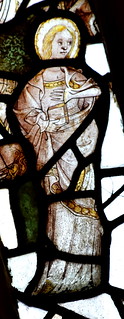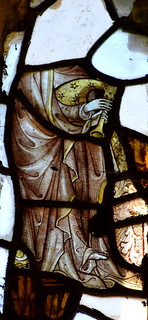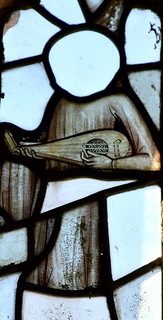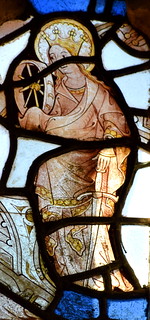| |
|
St Peter
and St Paul, Sustead Over the last fifteen years or so I
have visited every medieval church in Norfolk and
Suffolk, but I have not been back to some of them for a
very long time. In August 2005, I visited some forty
churches in north Norfolk over the course of two days in
the company of the late Tom Muckley. It had been a deep,
hot summer, the lanes drowsy and full of green.
Now, in early May 2018, the awakening year at last cast
my mind back to summers past. The long, cold winter
months had finally come to an end. Now, almost ten years
after Tom's death, I found myself thinking back to those
two days, and of the churches that I had not returned to
since. One of them that was golden in my mind was St
Peter and St Paul at Sustead, one of those pretty little
round towered churches in the area south of Sheringham.
And so, at the start of the bank holiday weekend, with
temperatures in the high twenties promised, I took my
bike on an early morning train up from Ipswich to West
Runton between Cromer and Sheringham on the north Norfolk
coast.
It was a gorgeous morning. I planned to cycle back to
Norwich, a journey I have made several times before and
always by a different route. A steep climb up through the
woods along the sunken lane took me across the A140 and
then down the hill into the grounds of Felbrigg Hall. I
locked my bike in the almost empty car park, and headed
for the gate to walk across the fields to Felbrigg
church, but stuck on the gate was a handwritten notice,
reading 'we regret the church is closed while the west
window is repaired'. Presumably they are storing all the
stuff in the church.
This was a disappointment, but it would save me time that
might allow other churches further on. The narrow lane
through the woods descended southwards. The land was
boiling with green and yellow, and there was nothing
about, no cars, no people, except an old lady standing by
the side of the road at an unmarked stop waiting for the
weekly bus into North Walsham. I came down into Sustead,
just a handful of houses and the pretty church. My heart
sank when I saw that the chancel was encased in
scaffolding and builders fences, but they were only
replacing the roof tiles, and the church was open.
The walls are pleasingly patched up with the red brick of
various ages. l had read that the architect and landscape
gardener Humphrey Repton had lived for ten years in a
house in the village, and must have known the church
well. I looked for hints of the late 18th century, but I
don't suppose he did much here, always being busy sorting
country houses out. Still, the locals must have known who
he was, and it was amusing to imagine the churchwardens
knocking on his door, tugging their forelocks and asking
for his advice on the drains.
You wouldn't have known inside that the scaffolding was
there. Everywhere seemed brightly painted and fresh in
this lovely little church.There is no tower arch, there
is no means of communication between the tower and the
nave. Instead, the tower has an external door on the
south side as at neighbouring Aylmerton, a local fashion
perhaps. The nave has a pleasing mix of 14th and 15th
century windows, Some with 15th Century glass. St
Catherine and St Mary Magdalene are partly restored, and
there are two musicians, one playing the bagpipes and the
other a rebec. Curiously, the bagpipes appear to be
leopardskin, with a leopard's head where the bag feeds
the pipes.
   
There is
the ghost of a former transept in the north wall, and in
front of it a delightful little late 17th century pulpit
with angels carved on it, curious to say the least. It
originally came from the redundant church at North
Barningham across the fields, now in the care of the
Churches Conservation Trust. The 15th Century font is
rather remarkable, featuring shields including those of
England and France, perhaps carved to mark the end of the
Hundred years War.
The south chancel windows are by Christopher Whall, and
depict the stories of the Good Samaritan and the Prodigal
Son, dating from the 1890s. A generation later, the 1920s
left another curiosity. The east window has restrained
motifs of late Art Nouveau, but the central top light is
unashamedly Jazz Modern, the kind of Art Deco that was
used in cinemas and road houses, and in the cabinets of
radios. If this is contemporary with the motifs below,
then it shows two major schools of 20th century design in
transition from one to the other, an unusual survival,
especially in a church.
I stood, and took one last look. Such a lovely, peaceful
spot. I would not leave it another thirteen years before
I came back.
And then I headed a short distance along a quite lane
between a barley field and an oilseed rape field to the
church at Thurgarton, less than a mile off. Halfway along
the lane I stopped, to take a photograph of Sustead
church across the barley field. I went to resume my
onward journey, reached for my sunglasses on top of my
head, and discovered that they weren't there. I'd left
them in Sustead church. And so, I turned and revisited
rather sooner than I had planned or imagined.
Simon Knott, May 2018
|
|
|
